|
| |
Teaching Tools and Techniques
Health Education: A supplement to Issue no. 39 - December 1989
pdf
 version of
this Issue version of
this Issue
|
There is much information in this issue that is valuable
and useful. Online readers are reminded, however, that treatment guidelines and health
care practices change over time. If you are in doubt, please refer to
WHO's up-to-date Dehydration Treatment
Plans.
|
Pages 1-6 Teaching Tools and Techniques
A supplement to Dialogue on Diarrhoea Online
Issue 39 - December 1989
|
DDOnline Teaching
Tools and Techniques supplement to DD39  Page 1 2
Page 1 2
HEALTH EDUCATION TEACHING TOOLS AND TECHNIQUES
Community health education is an important part of primary health care. Learning about
how illnesses such as diarrhoea are caused and what can be done to prevent them can help
to improve community health. Community health education should build on local beliefs and
practices, and should use teaching methods and techniques which are culturally appropriate
and relevant. Many health workers do not have training in teaching techniques, nor in how to make and
use basic educational aids. This DD Health Education supplement is intended
to help those who may be responsible for initiating health education with the community,
by providing some examples of ideas about ways to teach and how to make simple teaching
aids. Learning by doing The best way to learn is to be actively involved. Books and manuals are valuable, but
their use is limited in communities where few people can read and write. Long talks
without illustrations can be dull to listen to. Practical activities may be more
appropriate ways of teaching and learning. Good health education helps people to work out
solutions for themselves. Effective teaching aids need not be elaborate or expensive. Many of them can easily be
made from local materials at little or no cost, with the participation of local people.
Making teaching aids is often part of the learning process, and should be included in the
dialogue between the health worker and the community: It is important to remember,
however, that all teaching aids should be carefully tested to make sure that the message
they are intended to convey is well understood and accepted. If people are not used to
learning from pictures, another way should be found to help them understand basic health
messages. Images or activities that are not culturally acceptable may do more harm than
good. The best way to ensure that they are appropriate is to involve members of the
community in making them.
How to make an easel
|
You
will need:
- three long tree branches
- string
Tie the branches together at the top, and allow them to splay outwards. Boards may be
rested on protruding twigs. |
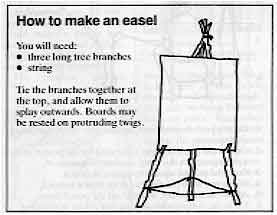 |
|
Using pictures
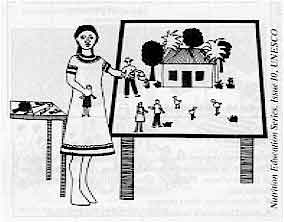 |
Visual images
can be a very useful way of conveying health messages. Existing materials, such as parts
of DD or other newsletters, or The Copy Book (see Resource
list) can be used to make posters or wallcharts, and may be adapted for local use.
Walls can be made into billboards for display. For small groups, a simple easel can be
made to carry a blackboard, flipchart or flannelboard. |
How to make and use a flannelboard You will need:
- a piece of plywood, fibreboard or strong cardboard
- soft cloth to cover the board
- cut-out pictures
Stretch the fabric over the board and fix it at the edges. Pictures for the
flannelboard may be cut out of magazines, copied or drawn by the participants. To make
them stick to the fabric of the board, back them with sandpaper, or smear the backs of the
pictures with a paste made of flour and water, and then sprinkle wheat or rice chaff on
the paste while it is still wet. Allow this to dry, and the resulting rough surface will
hold the pictures in place on the soft cloth. With suitable pictures, a story can be very effectively told using a
flannelboard. To
make your presentation as good as possible:
- plan your presentation
- rehearse and pre-test the presentation, preferably with a critical audience
- use only large, clear pictures
- do not crowd the board with too many pictures
- lean the board slightly backwards so that the pictures stick well
- remember to stand beside the board, not in front of it!
|
|
DDOnline Teaching
Tools and Techniques supplement to DD39  1 Page 2 3 1 Page 2 3
| Teaching Tools and Techniques |
How to make a chalkboard
|
You
will need:
- a sheet of plywood or fibreboard (about 5.5 x 57 cm)
- matt black paint
|
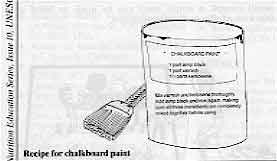 |
If possible, roughen the surface of the board before painting the first coat. Allow to
dry, roughen the surface again, and apply a second coat of paint. When the paint is dry,
rub the board with a cloth covered in chalk dust. This will make it easier to rub out
chalk marks later.
|
Making posters Posters can convey a single, simple message very strongly. They can be displayed in
health centres, clinics, schools, or in public places. Points to bear in mind when
designing a poster are:
- choose large, clear images
- avoid too much unnecessary detail or background
- include only the relevant details which are essential to the message
- avoid complex ideas which are hard to represent visually
- avoid the use of objects shown larger than they really are within a picture-this may be
misleading
- do not use technical drawings
- select colours, where used, with care, so that they fit in with the message, make people
want to look at the poster, and are culturally acceptable
Different cultural groups will respond to different types of visual image. In some
countries photographs are familiar, in others it may be better to use outline drawings.
Careful use of colour is important because, although it can help make a poster more
attractive and effective, certain colours have a significance in themselves which may
undermine the message of the poster. Using words It is important that any writing used is clear and easy to read:
- make the letters big enough to be easily seen
- keep the style of the letters simple-printed capitals are usually best
- leave enough space between words and lines
- be sure that the contrast between the colour of the background and of the letters is
clear so that they are easy to see
Where it is appropriate to use written materials for health education, try to choose or
make those which are as clear as possible. Written materials should be:
- attractive, easy to read, with plenty of space and pictures
- broken into short sections
- as short as possible, with the most important points at the beginning
- written with the shortest and simplest words possible
|

|
Use a simple lettering style
|
Copying and adapting pictures When you have chosen your picture, you can copy it as illustrated below.
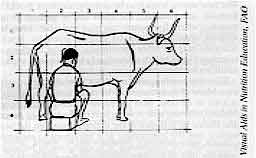
To make a copy the same size as the original, use squares of the same size. To make the
copy bigger,use bigger squares.
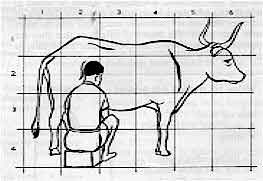
- Draw a grid of equal sized squares over the picture using a soft pencil.
- On a blank piece of paper to be used for the poster, draw a plain grid with the same
number of squares.
- Copy the picture square by square in pencil.
- When you have the outline, draw over it in ink.
- Allow the ink to dry, and rub out the pencil lines.
- Fill in the outline with shading and colour as required.
|
|
DDOnline Teaching
Tools and Techniques supplement to DD39  2 Page 3 4 2 Page 3 4
| Teaching Tools and Techniques |
Adapting pictures
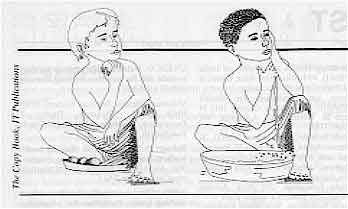 |
Certain
details in a chosen picture can be changed to more appropriate ones, for example, changing
hair or clothing or combining two images to create a new picture. It can be useful (and
fun) to work in a group to adapt pictures. This can be a good way to involve other people
and encourage them to participate in learning activities. |
Games
|
Nutrition
playing cards
Another way of using visual images is with games. These could be either board games,
such as 'snakes and ladders', or picture card games. Games are a good way to involve
people in active learning, which is always the most effective kind.
|
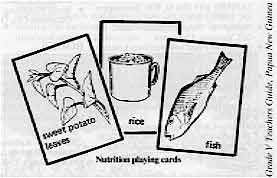 |
Taking part in a game is far more interesting than listening to a talk, and the
messages are more likely to be remembered. The board game illustrated shows how certain
practices will result in illness, and other practices in health and growth. The card game
is suitable for older children or adults, and can be used to test what knowledge has been
gained, for example after a class which used flannelboard or chalkboard with discussion or
role playing. People can always be involved in making up their own games - they can make
the rules, or just the cards and boards, for example.
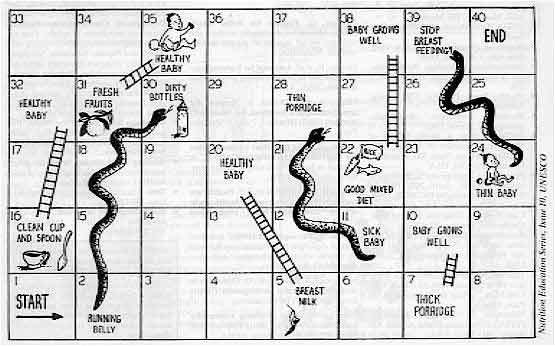
|
|
DDOnline Teaching
Tools and Techniques supplement to DD39  3 Page 4 5 3 Page 4 5
| Teaching Tools and Techniques |
Using dolls Key points about dehydrating diarrhoea can be effectively illustrated using these two
simple teaching aids. Children can be involved in making the 'baby' dolls and quickly
learn the signs of dangerous dehydration in infants. Gourd baby: learning the different signs of dehydration
Glove baby
This can be made from an old glove or sock, with an egg or stuffed ball for the head.
|
hand held straight
- belly wrinkle stays
fingers curved - skin springs back
|
When the 'belly' is pinched, the wrinkle stays. |
 |
Using a doll like this makes the test more realistic.
It also turns learning into a game.
|
In this position, wrinkles will not stay after the skin is pinched.
Pinch here. Wrinkles disappear.
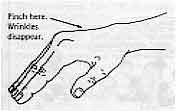
This is like the skin on the belly of a healthy baby.
|
But in this position, the pinched skin stays wrinkled for a moment -
just as on the belly of a dehydrated child. Wrinkles stay.
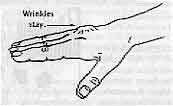
This is like the skin on the belly of a dehydrated baby. |
|
When you show the belly wrinkle test to children, make sure they realize that the test
should be done on the belly of a baby, not on the hand. You can have the children make a
doll like this, out of an old glove or stocking and an egg.
|
Using drama, song and storytelling
|
Drama can be entertaining and educational Health education messages can be effectively put across through songs and stories.
Children especially will quickly take in such messages and can pass them on to their
parents. Everyone in the community can learn from dramas or performances of song and
dance. Popular songs and drama, which may be broadcast through mass media (radio and
television), can also be used to reach the general public.
|
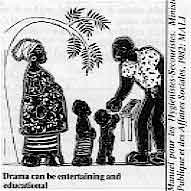 |
|
|
DDOnline Teaching
Tools and Techniques supplement to DD39  4 Page 5 6 4 Page 5 6
| Teaching Tools and Techniques |
Using puppets

If you are planning to use puppets for health education, ask yourself:
- what story will be used, and who will make it up?
- what information will be used in building up the story?
- what is the aim or result hoped for?
- how will you find out whether this has been achieved?
- what support and follow-up will there be?
Appropriate stories can be developed using local experience, beliefs and culture. Be
careful to appeal to what people understand, or - better still - ask community members to
develop stories, Identify the major health problems in your area and explore ways to help
people to overcome them through the puppet show. It is very important to be responsible
about the message contained in the show: unrealistic drama will either raise false hopes
or be ignored by people. Plan what follow-up there will be after the puppet show or series
of shows. Making puppets There are various types of puppet, some of which are extremely simple to make, and
others which, although more work is needed, can still be made at very little cost.
Children usually enjoy making puppets. Different types of puppet are:
- glove puppets with papier mache or clay heads
- rod puppets
- paper bag puppets
- vegetable puppets
- jointed puppets
- shadow puppets
The puppet stage or theatre
|
Visual Communication Handbook. Lutterworth Press A puppet stage can be just a wall or curtain for the puppeteers to stand behind while
they operate the puppets. You can hang a blanket or large piece of cloth between two
trees, or across a doorway, or use the window of a house. Or, you could make a simple box
theatre using wood or mats which could be taken apart and easily transported.
|
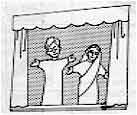
|
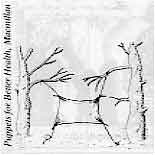 |
For shadow
puppet shows, all that is needed is a large sheet of thin fabric that light will shine
through. This can be hung between trees or poles. Remember to position the light source so
that the puppets will cast shadows in the way you want. It is important to position the
light safely, particularly if you are using paraffin or kerosene lamps, or candles. |
Putting on a puppet show
|
Invite
the audience to join in the talking For an effective show, remember to:
- use music and dance
- have plenty of action: people are not interested in puppets which just talk
- keep your speeches short and clear
- have a mixture of emotions (happiness and sadness) - this gives variety and holds the
attention of the audience
|
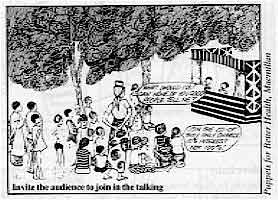 |
- aim for clarity of plot; have a single idea at the centre of the drama, with all action
contributing to this
- be appropriate to the local culture and use local languages
- use sound effects and props if you can make them
- involve the audience: have the puppets ask them questions and demand a response.
|
What do people think of the show?
Questions which should be asked after the puppet show include:
- can the performance itself be improved? Was it well received?
- did people get involved - in planning and at the time of the performance?
- has the show changed knowledge or behaviour?
|
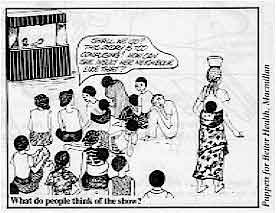 |
|
|
DDOnline Teaching
Tools and Techniques supplement to DD39  5 Page 6 5 Page 6
| Teaching Tools and Techniques |
RESOURCE LIST SOURCES OF INFORMATION AND MATERIALS These organisations supply teaching aids, books, manuals and other types of educational
materials, some of which are listed below.
- AKAP, 66 JP Rizal St, Project 4, Quezon City, Philippines
- African Medical and Research Foundation (AMREF), PO Box 30125, Nairobi, Kenya
- American Public Health Association (APHA), 1015 15th St, NW, Washington DC 20005, USA
- Atelier de Material Audio-Visuel, BP 267, Yaounde, Cameroon
- Caribbean Food and Nutrition Institute (CFNI), PO Box 140, Kingston 7, Jamaica
- Centre for Health Education Training and Nutrition Awareness (CHETNA), Drive-in Cinema
Building, 2nd floor, Thaltej Road, Ahmedahad, Gujarat 380 054, India
- Child-to-Child Programme, Room 634, 20 Bedford Way, London WC1 0AL, UK
- Christian Medical Commission (CMC), 150 Route de Ferney, 1211 Geneva 2, Switzerland
- Clearinghouse on Development Communications (CDC), 1815 N Fort Myer Drive, Suite 600,
Arlington, VA 22209, USA
- Editorial Pax Mexico, Av, Cuauhtemoc 1434, Mexico 13 DF, Mexico
- ENDA Tiers Monde, BP 3370, Dakar, Senegal
- Hesperian Foundation, PO Box 1692, Palo Alto, CA 94302, USA
- Intermediate Technology Publications, 103 Southampton Row, London WC1, UK
- Mambo Press, PO Box 779, Gweru, Zimbabwe
- Macmillan Publishers, Houndmills, Basingstoke, Hants, UK
- MEDEX, John A Burns School of Medicine, University of Hawaii, 1833 Kalakaua Avenue,
Suite 700, Honolulu, Hawaii 96815-1561, USA
- Program for Appropriate Technology in Health (PATH), Suite 700, 1990 M Street NW,
Washington DC 20036, USA
- Popular Education and Primary Health Care Network, Diagonal Oriente 1604, Casilla 6257,
Santiago 22, Chile
- Resources for Child Health (REACH), John Snow Inc., Ninth Floor, 1100 Wilson Boulevard,
Arlington, VA 22209, USA
- Teaching Aids at Low Cost (TALC), PO Box 49, St Albans, Herts AL14AX, UK
- UNESCO, 7 Place de Fontenoy, 75700 Paris, France
- Volunteers in Technical Assistance (VITA), 3706 Rhode Island Avenue, Mt
Ranier, MD
20822, USA.
- Voluntary Health Association of India (VHAI), 40 Institutional Area, South of
IIT, New
Delhi 110 016, India
- Water and Sanitation for Health (WASH), Information Center, 1611 N Kent St, Room 1002,
Arlington, VA 22209, USA
- World Health Organization (WHO), 20 Avenue Appia, 1211 Geneva 27, Switzerland, and WHO
Eastern Mediterranean Regional Office, PO Box 1517, Alexandria, Egypt
- World Education, 251 Park Avenue South, New York, NY 10010, USA
- World Neighbors, 5116 North Portland, Oklahoma City, Oklahoma 73112, USA
BOOKS Aarons, A, and Hawes, H. Child-to-Child (1979). Well-illustrated manual
with ideas about how children can teach other children and their parents. Child-to-Child.
Abbatt, F R, and McMahon, R, Teaching health care workers: a practical guide (1985)
Macmillan. TALC
CHETNA. Kathputli se seekhna aur seekhana (Teaching and learning with puppets)
(in Hindi), CHETNA.
Fetter, K A, et al. Teaching and learning with visual aids: a resource manual for
community health workers, health trainers and family planning workers in Africa and the
Middle East. TALC.
Gordon, G. Puppets for better health (1986). Manual for community workers
and teachers on all aspects of puppet-making and use. Macmillan.
Harner, R, et al. A manual for learning exercises: for use in health training
programmes in India (1983). VHAI.
Hope, A, and Timmel, S. Training for transformation: a handbook for community
workers (1984) (Books 1,2 and 3). Mambo Press.
Jarmul, D. Plain talk: clear communication for international development (1981).
A manual on how to write simply for development education. VITA.
Johnston, M P, and Rifkin, S B. Health care together: training exercises for health
workers in community based programmes (1987). TALC.
Linney, B. The copy book (1988). A collection of copyright-free illustrations
donated by various artists, which may be copied or adapted. IT Publications.
Macdonald, I, and Hearle, D. Communication skills for rural development (1984).
Evans Brothers/ IT Publications.
Stinson, W, et al. Training community health workers (1983). World Federation of
Public Health Associations. APHA.
UNESCO. Nutrition education series: easy to make aids for nutrition
teaching-learning (1984). UNESCO.
Voluntary Health Services Society, (23/4 Khilji Road,
Shyamoli, Dhaka 7, Bangladesh), Guide
to public health films in Bangladesh.
Werner, D, and Bower, B. Helping health workers learn (1982). Hesperian
Foundation. An excellent manual, full of practical ideas and advice. TALC.
WHO. The community health worker: working guide. Guidelines for adaptation (1987).
WHO.
WHO. Education for Health. (1988) WHO.
Zimmerman, M, et al. Developing health and family planning print materials for low
literate audiences: a guide. Illustrated guide which can be used to develop teaching
materials. PATH.
NEWSLETTERS
- Agripomo. QuarterIy magazine (French). Subscription. INADES Formation.
- Cajanus. Quarterly journal (English). Subscription.
CFNI.
- CHETNA News. Quarterlv journal (English). Free to health workers in India.
- Contact. Bi-monthly magazine (English/ French/ Portuguese/ Spanish). Free to
developing countries. CMC.
- Development Communication Report. Quarterly newsletter (English). Free to
developing countries. CDC.
- Health and Popular Education. Irregular newsletter (English/ Spanish). Free to
developing countries. Popular Education and Primary Health Care Network.
- IRED Forum. Quarterly journal (English/ French). Subscription. Development
Innovations and Networks.
- Soundings from Around the World. Biannual newsletter reviewing new resources
(English). Subscription. World Neighbors.
- Teaching and Learning News. Irregular newsletter (Arabic/ English). Free. WHO
(Eastern Mediterranean).
- 2000. Quarterly newsletter (English). Free.
MEDEX.
- World Neighbors in Action. Quarterly newsletter (English). Subscription. World
Neighbors
|
AHRTAG resource list:
Health Education on Diarrhoeal Diseases (revised edition 1990).
Free to developing countries. AHRTAG is compiling a resource list of primary health
care health education materials. If you have found any teaching or educational materials
particularly useful, we would like to hear from you about them. |
Teaching Tools and Techniques
Health Education - A supplement to Issue no. 39 December 1989
Page Navigation
This edition of Dialogue on Diarrhoea Online is produced by Rehydration Project. Dialogue on Diarrhoea was published four times a year in English, Chinese, French, Portuguese, Spanish, Tamil,
English/Urdu and Vietnamese and reached more than a quarter of a million readers worldwide. The English edition of Dialogue on Diarrhoea was produced and distributed by Healthlink Worldwide. Healthlink Worldwide is committed to strengthening primary health care and
community-based rehabilitation in the South by maximising the use and impact
of information, providing training and resources, and actively supporting
the capacity building of partner organisations. - ISSN 0950-0235 Reproducing articles
Healthlink Worldwide encourages the reproduction of
articles in this newsletter for non-profit making and educational uses. Please
clearly credit Healthlink Worldwide as the source and, if possible, send us a copy of any uses made of the material.
|
updated: 4 March, 2016
|
version of this Issue